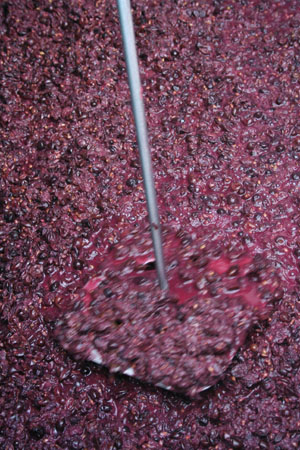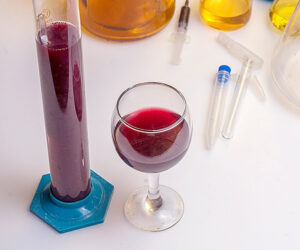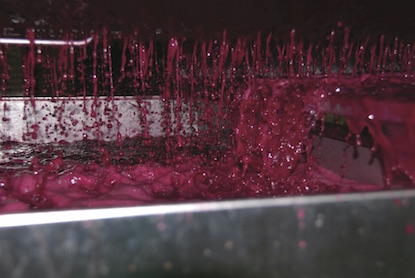
Red and white wines each have a generally recognized range of numbers for the pH, TA and ºBrix that are known to make a nice wine; (Red wine: pH 3.4–3.7, TA 6.0–7.0 g/L, 22–25 ºBrix. White wine: pH 3.2–3.5, TA 6.0–9.0 g/L, 17–24 ºBrix). Ideally, when our fruit hits the destemmer-crusher, we would like to see each of the pH, TA and ºBrix values test somewhere within these desired ranges. However, make wine long enough and pretty quickly you will see that all grapes are not created equal. Depending on the region, varietal, grower, vintage, etc., your fruit may test to have a pH anywhere from 3.0–4.2, a TA from 4.5–10.0 g/L, and sugar ranging from 15–28 ºBrix! Our ideal target for the pH, TA and ºBrix is actually somewhere roughly in the middle of these ranges. Therefore, when any of the pH, TA and ºBrix values for our must come in over or under our ideal ranges, we should takes steps to correct them back into the desired ranges.
For those of you who feel that they may not want to bother with the adjusting the must and instead correct the wine once the fermentation is over, here are two reasons why you may want to reconsider that approach — a balanced must makes a balanced (and better) wine and the ideal time to make an adjustment to the wine is during its brief infancy before it has actually become wine.
These are actually interconnected; let’s take a look at how, starting with a balanced must makes a balanced (and better) wine. The act of fermentation is an act of creation and construction. During the complex transformation from juice to wine, wine will continually put itself together using whatever materials are available in the must. To use a construction analogy, if the must is in balance, it essentially has all of the required raw materials to build a complete, well-made structure that’s up to code. However, if the must is not in balance, it means that we may not have all of the required materials to build the structure we might have hoped to end up with. Instead of a lovely house, maybe we end up with a storage shed! The bottom line is, if we don’t have all of the materials we need in the correct amount, then we are limited in what we can ultimately build.
We can address the second point above concerning the timing of the additions using the same construction analogy. Say in the course of building our new house we decide to change the plans and add a third bathroom and increase the size of the windows. If we had this figured out before we started building, then it’s no big deal to incorporate these big changes. However, if we decided to make these changes after all of the plumbing and sheet rock was finished (i.e., much later in the construction phase) this would be much more difficult to integrate into the final project. It is the same exact thing with wine. The earlier we make changes, the easier it will be to integrate them into the wine. And, any adjustment made before the wine starts assembling itself will integrate more gracefully into the wine than the same adjustments made after fermentation.
Evaluating Our Musts
Now that we have taken a look at why we should be looking to adjust our musts, let’s look at how we can best approach it. The most important thing to remember when evaluating your must is to understand that just as we assess structure, complexity, acidity, length of fruit, etc. in a finished wine, we should be doing the same for the must during the crush. The tricky part is that each of these three elements we are looking at needs to be singled out for inspection and viewed as part of a whole at the same time. In other words, it’s important to know the pH of the must, but ultimately it’s how that pH in that must tastes that really matters. It is the same with the TA and structure elements (tannins and mouthfeel) as well.
pH/TA
Without a doubt, pH is the most important element to get a handle on when evaluating a must. If you adjust nothing else, try and get the pH of the must in the recommended range! We’ll use examples from both high and low pHs to illustrate why it is important to get the pH properly adjusted before fermentation begins.
High starting pHs can cause problems in your wine. In a joint research project between Lallemand Australia and the AWRI (Australian Wine Research Institute), Eveline Bartowsky (from AWRI) showed that high pH musts that were fermented as is and corrected to pH 3.5 after fermentation retained far less berry, fruit and spice characters than if the same must were corrected to pH 3.5 before the fermentation begun. The moral of the story is once the original fruit and aromatics are gone, you do not get them back. So take steps to preserve them up front by adjusting your high pHs down using tartaric acid before the fermentation begins. A helpful hint is not to forget to factor in the change in TA when deciding how much you may want to shift the pH. If you have a high TA with your high pH, you will not be able to make as big of an adjustment to the pH than if you had a lower TA.
In addition, low starting pHs can cause other problems. A pH 3.2 is an important break point. Below this and you may have trouble with many yeast strains becoming stressed and acting out by creating VA, H2S and possibly not finishing the fermentation. When evaluating a low pH must to see whether you need to adjust it up, keep in mind that at the beginning of fermentation there is a drop in pH due to the metabolization of nitrogen by the yeast. The nitrogen acts as a buffer against the TA of the must. Once the yeast metabolizes it, it is no longer available to counteract the acidity of the wine. However, once alcohol is produced the pH will start to come back up again.
The severity of this pH drop at the beginning of alcoholic fermentation will be must-dependent, largely affected by the amount of potassium in the must. This is because just as with nitrogen and alcohol, potassium also buffers the acidity in the must. Potassium comes from the skins, so if you will have skin contact either during fermentation or must preparation, you can expect to see a rise in your pH. Depending on how low your pH is you may not need to correct the must to keep it from dipping below 3.2 and stressing your yeast.
However, if your musts are pH 3.2 or below and you are not spending time on the skins (a source of potassium), then you may want to consider adding potassium carbonate to the must to adjust the pH up a little to compensate for the early pH drop. Although 1.0 g/L will raise the pH by 0.1 units on paper, because of the complex nature of buffering, it is highly recommended to do a bench trial to determine the proper amount you need for your wine. However, this is not often feasible during crush, so you can also just add the amount you think you need in ¼ increments while making sure to be mixing thoroughly and double checking the pH shifts as you go. The carbonate should be mixed with juice or wine, not water.
Structure
Anything that involves mouthfeel and tactile impressions on your palate I refer to as structure. Between the pH, TA, and sugars, structural elements may be the most frustrating for the more number-centric of us to wrap our brains around. This is because since tannin assays and gas chromatographs are out of the reach of most amateur winemakers, there are no definite values to use as a reference to measure structural elements. Instead, we have to rely on a completely arbitrary framework to determine if a must needs any structural reinforcement: our palates. However, if we remember that in the end it is our palates that should be the bottom line for any adjustment we make anyway, then maybe it is not so bad. That being said, here’s how we can taste and evaluate the structural elements in a must:
Tannins
Tannins are complex molecules and their molecular structure determines their impact. Short chain tannins are harsh, bitter and astringent. Longer chain tannins are softer, rounder and create a nice mouthfeel. When evaluating the quantity and quality of tannins in a must, we actually just taste for these same qualities. Quite simply, we are just looking at whether the juice has any bitter, drying, chewy, soft, round qualities, etc. Because the sugar levels in must are so high as to interfere with being able to focus in on the tannins while the sample is still in your mouth, you will get the most clarity about their make-up on the after-palate, after you have spat or swallowed the sample.
The tannins we have in grapes come mainly from the skins and seeds. However, depending on how careful you are during the crush, you may have some unwanted tannic contributions from the stems and leaves, as well.
It’s important to pay attention to the color of any material that makes it into your must. When the grape ripens, one of the phenolic ripeness indicators we are looking for is when the seeds (and stems) turn brown. This is referred to as lignification and is actually a modification of the tannin molecules as they become more complex, and in the process move from being bitter to nutty. Remember: Brown is good — Beware the green!
SIY
Specific inactivated yeast (SIY) are yeast that have been processed in such a way as to contribute a maximum of polysaccharide and mannoprotein fractions to the wine. While they help to stabilize color, they’re primarily used to round out and smooth over elements that could be unpleasant or aggressive in a must. When evaluating a must, if it’s really thin, or you get any harsh, bitter, unripe/green, or sharp characters, adding an SIY can really help smooth it over while adding to the mouthfeel of the wine. In short, an SIY is not really something you taste for, rather it is something you use to correct a problem with. Think of it like cream cheese on a toasted bagel!
Pectinase
I list pectinase enzymes under the structuring section because of their impact on the must. Pectinases break down the grape skins, which causes the release of anthocyanin (pigment) and water-soluble, soft tannins into the must. As with the SIYs, you don’t really taste for enzymes, but their effect on the must is beneficially rounding and is another tool to help you balance out your must.
Sugars
Sugar is alcohol. Or at least part of it will be once the fermentation is over. Each 1 °Brix consumed by the yeast is converted to approximately 0.60% alcohol. As lovely as this is, too much can be a bad thing. High sugar musts (°Brix > 25) create an osmotic shock that can stress yeast to the point of sticking fermentations. Some yeast strains are better adapted at fermenting high Brix musts, and it is not unusual to have a wine be able to reach 16+% alcohol.
The problem with high-alcohol wines, however, is that they are hot and the tannins and acidity are often edgy and not well integrated into the wine. They may be novel for the first few sips, but in the end they wind up being fatiguing to drink and are ultimately out of balance.
Interestingly enough, if you lower the alcohol in that same wine, the balance comes back. In a series of alcohol reduction trials, I was lucky enough to taste a few years back, in each case the effect was the same. As the alcohol level was decreased in the wine, there were multiple points at which the wine came back into balance with itself. These were referred to as “sweet spots.” For each of the wines the pattern was the same. The sweet spots varied from wine to wine, but became more frequent as you moved from around 16.5% ABV back to 13.5% in all the wines. In addition, the further you got in the lower alcohol levels, the less extreme the edginess of the wines outside of the sweet spots were. What this means is that although we may not be able to dial in our wines to an exact alcohol percentage in our own wineries, we can raise the odds in our favor that our wines will end up in a more balanced spot if we avoid making high-alcohol wines. And the way we do this is by diluting the sugars in the must before they can become alcohol. Amelioration is not a crime (in the must stage).
Adjusting a Must
When adjusting a must, there are many challenges. In red wines, the pH is constantly shifting. Beware the buffer capacity of the must. You will often get a clearer idea of what you will have on the second day of maceration. This is due to the release of potassium from the skins. pH usually goes up, especially if you are using any enzymes. With regards to sugar content, beware if there is any raisining or shriveling in the fruit, as these berries hydrate during the fermentation and release their sugars during cap maintenance, your Brix and therefore, alcohol level can rise dramatically. If you can sort these clusters or berries out, best they never make it to the crusher. Don’t be afraid to adjust the must, however, don’t be seduced by theory and the numbers alone. Science is great, but it is only the means to an artistic end. You must taste and let that be your final guide. Get all of the information before you begin, understand why you are adding a certain product or making a certain adjustment.




